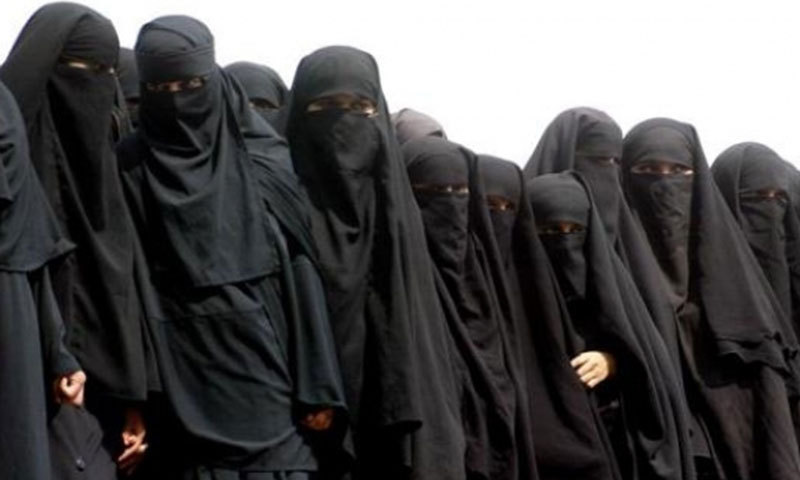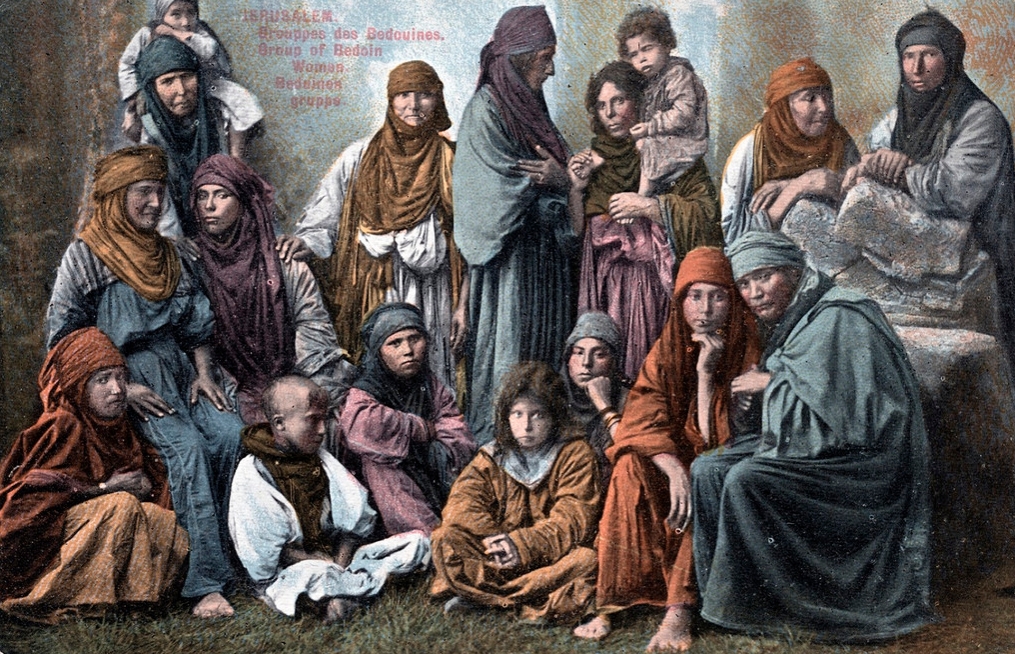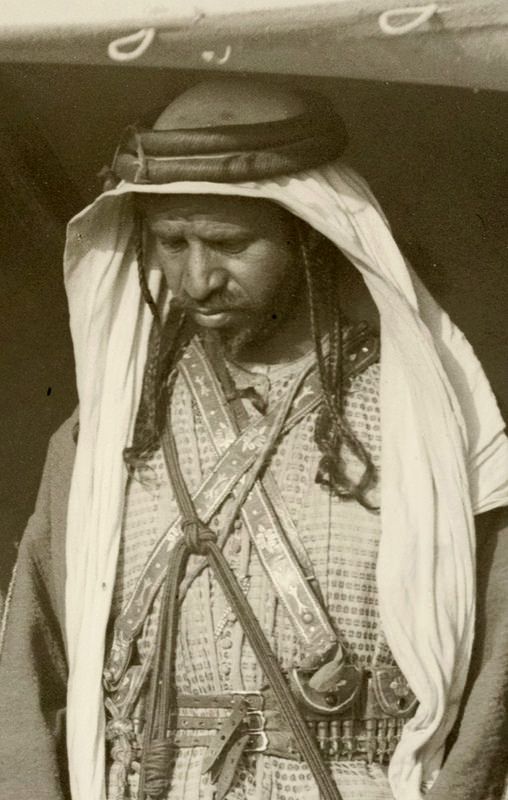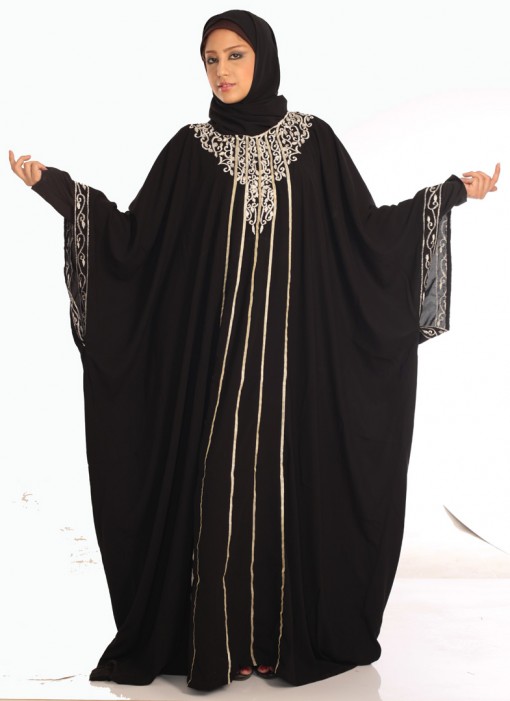
History of clothing in Arabian Peninsula :
During the early Islamic period, (7th century AD) there were very limited options of hand-woven traditional patterns or plain off-white natural fabric. Only very rich people could afford imported colourful glossy textiles from China, India, Africa or Europe. Aam janata, or the common people, always wore the cheapest and the most easily available clothes.
At around that time women wore dresses that revealed their necks, chests, even breasts as well as other parts of their bodies. They also drew their veils backwards while leaving the front parts wide open (understandable in the crushing desert heat). Consequently, when Islam arrived, they were ordered to draw their veils forward to cover their chest and to protect women from acts of disrespect.

Old Arab Fashion
Some think that the idea of 'the covering' was more about class than it was about religion. In pre-Islam urban centers of the Arabian Peninsula veiling was seen as a sign of privilege and a luxury afforded to women who didn't have to work. They were distinguished from slave girls and sex-workers, who were not allowed to veil or cover, and nomadic and rural women too busy working to be bothered with something so impractical as a face veil and the extra layer of clothing.
The Arrival of Black Abaya (the full body covering for women)
1932: British forces attacked Ottoman Empire and formed KSA (Kingdom of Saudi Arabia it was the first Kingdom of a Bedouin tribe/family called Al-Saud).
1939 to 1945: During World War II, in Europe the issue of mourning in accordance with etiquette and custom required wearing Black. (especially for the war widows).Same black fabric was also exported by the UK to the newly-acquired business destination called KSA.
The Saudi-British trade was not limited to oil and gas; it included everything, food, clothing, vehicles, arms and ammunition, civil construction, industries, media, refineries etc. All of the Kingdom of Saudi Arabia (KSA) needed a new identity and a family's personal code was imposed on the entire kingdom.
The world textile industry was a monopoly of the British Raj, mass producing jet black Sulfur dyed textile was a very profitable business (for the Brits!). This jet black fabric appealed to the Bedouin Royal Priests in KSA, it was more opaque than the mass produced white fabric, therefore the less opaque and more suitable to the KSA climate white fabric became official colour for the males.

And, the Kingdom immediately made this jet black fabric into the official dress code for women. During the same time, there was a need all over the world to impose constraints of all kinds, the governments during and after the World War II, needed rationing of food, and clothing. The textile industry had imposed many constraints on users to stop the wastage of cloth. (This, in turn, by default, brought in fashion design revolution within Europe)
Now, in last 100 years or so, the Kingdom of Saudi Arabia has managed to export their own Bedouin family culture and tradition as "Islamic" culture and tradition. To justify the Black Abaya, people have come up with strange textual references, that say, for instance, that wearing any other colour is aping non-muslims, and by default, is then, against Islam. (While the black textile that the women are wearing is itself a British industrial mass produced cloth!)
Interestingly the recommended ‘ISLAMIC’ clothes for the Hajj Ritual is WHITE for both men and women, and it is mandatory for women to keep their face visible (not covered).

Saudi Abaya
New Businesses around the Abaya:
Germany's (Henkel) & UK's (Unilever) found a great business scope, they came up with a product called "Persil Abaya", it is specialised detergents for cleaning the black abaya. It is one of the most popular detergents and widely favoured in every Saudi, Qatari, Omani, Kuwaiti household.
Also the suppliers of both the Black and White fabrics (mostly European-reseller companies who source their fabric from Asia) and don't want KSA to change the dress code.
Re-inventing the Saudi abaya:
A Riyadh based designer Eman Al-Mandeel has updated the traditional black Saudi abaya with luxurious fabrics and colour – and her creations have been an unexpected success. While tolerance of Al-Mandeel’s designs in Saudi Arabia may mark a step towards greater acceptance of women in Saudi life, it is worth reminding ourselves that the many rights that women lack in Saudi Arabia cannot be bought on a shopping trip.
(The author is a communication designer)
Refrences:
1. The Abaya: Fashion, Religion, and Identity in a Globalized World by Elizabeth D. Shimek, Lawrence University
2. Sulphur Dye
3. French Fashion during the First World War
4. DISCOVER THE ARAB WORLD : British Museum
5. The History of the Abaya, By James Brack
7. Islamic women with hijab, niqab, mysterious eyes, purdah, chador, modesty, covered, hidden, secret, Islamic women covered from the world
8. Persil Abaya : Gives Abaya a pleasant fragrance, has a special fragrance that was chosen after research with Saudi consumers.
9. The impact of World War II on women's fashion in the United States and Britain, Meghann Mason, University of Nevada, Las Vegas
10. World War II and Fashion: The Birth of the New Look, Lauren Olds, Illinois, Wesleyan University
11. Reinventing the Saudi abaya
12. Saudi abaya comes into fashion
13.The color black may seem like an odd addition to fabric celebrating a wedding, but there was a reason for the color choice. German firms were the most important manufacturers of synthetic textile dyes and colorants in the early 20th century. In March 1915, several months after the beginning of World War I, the British navy began to blockade German ports, preventing any exports of goods overseas. As a result, the textile and paper industries in the still-neutral United States suffered a serious shortage of good quality synthetic (chemically based) dyes. "Sulfur black" was the one dye that firms outside Germany produced in quantity and of consistent quality. Some firms reverted to old technology, and tried to adapt old formulas for natural dyes to modern industrial needs, but the quantities were small and the color range limited, and not always fast to light or washing.
Fashion magazines from the period illustrate the efforts by many leading American textile and fashion manufacturers to create a fad for black and white clothing and accessories. French and English fashion firms, suffering under the same dye shortage, were also promoting black and white. In those countries, however, already at war, black and white clothing carried overtones of loss and mourning that were not yet relevant to most Americans.